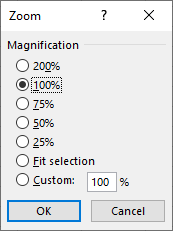Please Note: This article is written for users of the following Microsoft Excel versions: 2007, 2010, 2013, 2016, 2019, 2021, 2024, and Excel in Microsoft 365. If you are using an earlier version (Excel 2003 or earlier), this tip may not work for you. For a version of this tip written specifically for earlier versions of Excel, click here: Zooming In On Your Worksheet.
Written by Allen Wyatt (last updated November 15, 2025)
This tip applies to Excel 2007, 2010, 2013, 2016, 2019, 2021, 2024, and Excel in Microsoft 365
When you are working with your data, you may want to enlarge what you see on the screen without actually changing the font size used by Excel. For instance, you may have formatted your text so that it uses a small font. (This is often necessary to get all your information on a printout.) When working in the worksheet, however, the font is difficult to read because it is so small.
The solution to this problem is to use the zooming capabilities of Excel to enlarge just what is displayed on the screen. Excel provides two primary methods to zoom in on your data. First, you can use the Zoom control at the bottom-right of the Excel window, at the very right-hand side of the status bar. Just drag the control to the left or to the right and Excel adjusts the size of what you see on the screen.
You can also see a selection of different zooming options by displaying the Zoom dialog box. There are two ways you can display the dialog box:

Figure 1. The Zoom dialog box.
Note that the Zoom dialog box includes six predefined zoom settings, plus a way you can specify any magnification level you want, between 10% and 400%. When you are done with your selection, just click on OK.
It is helpful to note that the Zoom group, on the View tab of the ribbon, includes two tools in addition to the Zoom tool. These two zooming tools will be very helpful to many people because they allow you to zoom in on whatever cells you have selected on the screen (Zoom to Selection tool) and to return to a normal display (100% tool).
ExcelTips is your source for cost-effective Microsoft Excel training. This tip (9093) applies to Microsoft Excel 2007, 2010, 2013, 2016, 2019, 2021, 2024, and Excel in Microsoft 365. You can find a version of this tip for the older menu interface of Excel here: Zooming In On Your Worksheet.

Excel Smarts for Beginners! Featuring the friendly and trusted For Dummies style, this popular guide shows beginners how to get up and running with Excel while also helping more experienced users get comfortable with the newest features. Check out Excel 2019 For Dummies today!
Do you want to display a particular range of columns within the Excel window? Here's a couple ways you can accomplish the ...
Discover MoreIf you are using a mouse that has a center wheel, you can use the wheel to zoom in and out of your work. This tip shows ...
Discover MoreExcel doesn't provide a keyboard shortcut that allows you to zoom in or out on your workbook. It is easy, however, to ...
Discover MoreFREE SERVICE: Get tips like this every week in ExcelTips, a free productivity newsletter. Enter your address and click "Subscribe."
There are currently no comments for this tip. (Be the first to leave your comment—just use the simple form above!)
Got a version of Excel that uses the ribbon interface (Excel 2007 or later)? This site is for you! If you use an earlier version of Excel, visit our ExcelTips site focusing on the menu interface.
FREE SERVICE: Get tips like this every week in ExcelTips, a free productivity newsletter. Enter your address and click "Subscribe."
Copyright © 2025 Sharon Parq Associates, Inc.
Comments